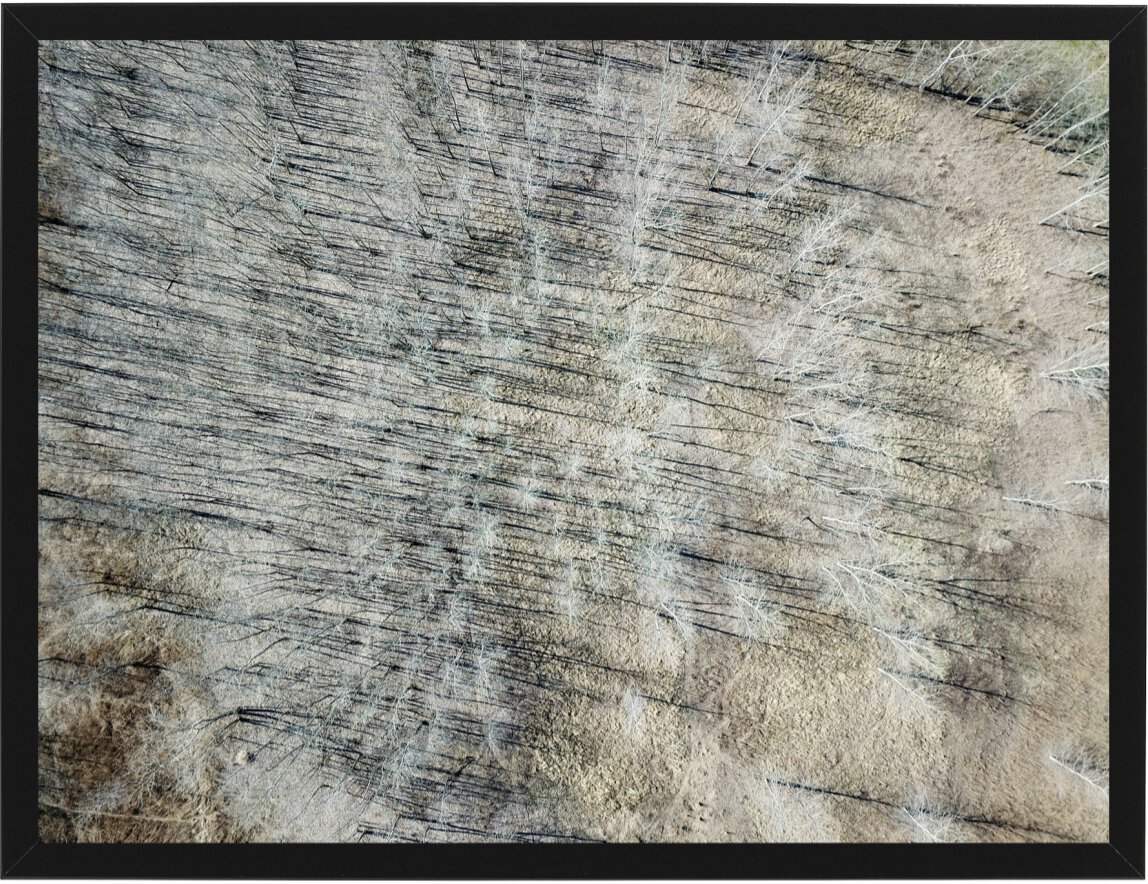Oui.Gallery Interviews St. Louis Based Aaron Owens
Featured Image: Aaron Owens, Trees in Early Spring, 2018. 100cm x 134cm, Archival color pigmented print.
Introduction of the artist
Contemporary artist Aaron Owens lives in St. Louis, USA, and claims to be a map drafter from Missouri, USA. He uses drones to capture marginalized landscapes and then transforms the images into works of art. Through his creation, he explored topics related to surveillance, human-natural confrontation, and modern ecology holism. His work has been published in VIEW Magazine, Tube Magazine and The Moon Electronic Magazine.

Aaron Owens, Flood, 2018. 100cm x 100cm, Archival color pigmented print.
Aaron said, “In my series, Order, I used a drone and open source software to more closely examine the overlap of people and the environment in areas around Saint Louis paying particular attention to those landscapes of consistent change such as the edge of the Mississippi River.”
How did exploring the theme of human versus nature help you develop your series Order? And why did you decide to tackle this theme?
The themes of “human and nature” or “human out of nature” emerged pretty naturally from the photos and video I was making at the time. Thinking back it was less about making the work match a theme and more about letting the media speak for itself. Consistently the most compelling images spoke to the false dichotomy of the human vs. nature narrative and offered a different perspective, a more complicated story.

Aaron Owens, Undisclosed Location (Red Barge), 2018. 100cm x 100cm, Archival color pigmented print.
You describe yourself as being a “geographer” and a “cartographer”. But do you consider yourself to be an artist? If so, why?
Yes, I would say I identify as a geographer first but I’ve become more comfortable thinking of myself as an artist. I construct, I make, I practice a visual medium – these are all things an artist does.
Your works focus on the elements of land and water. Can you talk more about how these elements helped to create your ideas?
Land and water, for a geographer and landscape artist what else is there? I think it makes sense as a way of breaking things down or organizing. Similar to putting the pieces together for Order the elements of land and water emerge and are more the result of following my instincts wherever they might lead and organizing later. The places that have consistently attracted me are marginalized areas, especially those areas where land and water meet. In St. Louis that often takes me to the rivers but also quarries and earth extraction sites which are made vulnerable to erosion and tell a specific story regarding the interruption of natural processes.

Aaron Owens, Island, 2018. 100cm x 100cm, Archival color pigmented print.
Who or what are your major influences? And what makes them, or it, so appealing to you?
My largest influence has been the people in the creative community in and around St. Louis. Specifically, the folks in the experimental music scene and the visual artists I had the opportunity to work with this past Spring when I helped organize the Art + Landscape STL show in the Granite City Arts and Design District. There’s a wealth of talent here and it is consistently inspiring to see and be a part of what people are doing. I could start to name names but the list would be too long.
How did using drones to create images of the environment and the people around them reflect on your perspective of the world?
The drone work grew out of my interest in and consistent exposure to aerial imagery. As I worked with publicly available aerials I began to want more control and greater detail which led to purchasing a drone. It’s been a useful tool in communicating a larger, more mysterious story of landscape.

One work of art that caught my eye was Wetland (2018). What went through your mind to make this piece, and could you describe it in three words?
Wetland (2018) is one of my favorites. It’s one of the first images I made after purchasing the drone I use now. Part of the challenge of working with a drone is you can not be sure what you will get once you put the thing in the air. On any given day you’ll never know just how a place will represent when viewed from above so, for me, the key is to try and remain open to the landscape and let it tell its own story.
Subtle. Neutral. Construct. When I look at the image now I see a wetland in late winter. It’s an image of an area readying itself, it’s subtly alive. Additionally, the area is a construction, an artificial wetland, a legislated garden. There are a lot of things happening below the surface in this photo.
How would you describe the relationship between yourself and the works you’ve created?
I tend to work quickly so my relationship to a lot of my work is fleeting. I will make something and move on and until recently, I seldom took the time to come back and reexamine or rework or rethink or reflect on a specific piece that resonates in some way. As I write this, it’s become a bit of a balancing act, trying to create while working through and with memory.

Aaron Owens, Wave, 2018. 100cm x 100cm, Archival color pigmented print.
As an artist, which word could better define your role in society? A prophet, dissident, intellectual, citizen, or other? And why?
I would say I think of myself as an observer first. So I suppose I’d go with “other.”
